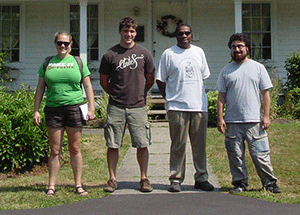Plantations Staff and Summer Interns Create Plans for New Gardens at the Harriet Tubman Home
A collaborative project involving Cornell Plantations and Cornell University landscape architecture students is focused on planting for the future while preserving the past. Plantations staff and summer interns from Cornell have been creating plans for new gardens at the historic Harriet Tubman Home in Auburn, NY.
Irene Lekstutis, landscape designer at Cornell Plantations and Landscape Architecture students from Cornell University who were interns at Plantations over the summer -- Daisy Chinburg ‘13, Robert Doerflinger ‘13, and Ethan Dropkin ‘13 –– met with Christine Carter of the Harriet Tubman Home several times this summer to discuss developing period appropriate planting plans, as well as creating a long-term master plan for future development of the property. It’s the desire of Ms. Carter and her colleagues to create gardens that Harriet Tubman would have grown during her life in Auburn, NY (1857 - 1913). 
“Engaging our summer interns who are majoring in Landscape Architecture in a ‘real –world’ project like this has been very gratifying,” stated Lekstutis. “When Christine contacted Cornell Plantations about helping them improve the aesthetics of the Tubman Home landscape, we were thrilled. We all agreed it would be a great way to enhance the intern experience by providing these students with a project related to their particular field of study.”
It has been a long-time commitment of Cornell Plantations to collaborate with gardens, and historic sites across the country. This project, being so close to campus, makes it easy for these students and Plantations to continue with this collaboration. Plantations’ summer intern program plays an important role at the University, by giving students real world experience. For these students, they just didn’t gain experience from working with the professional staff at Plantations, but they were able to garner experience working with a client. They had to listen to the client’s needs, and had to deliver a plan that was relevant to the client’s budget and wish list.
While outside projects such as these are not typical of the internships at Plantations, Lekstutis saw the opportunity to further enhance the interns’ summer learning experience. Daisy Chinburg ’13 says, "We really lucked out this summer! It’s been great to have the opportunity to learn more about Harriet Tubman, while practicing landscape design skills. And working along side Plantations’ professional landscape designer was a bonus!”
During the course of the project, the interns spent time in Mann Library perusing old nursery catalogues and books on historic gardens to become familiar with herbaceous and woody plants commonly grown in gardens and landscapes of late 19th and early 20th centuries. By the end of summer the interns completed a planting plan for the brick residence on the Tubman site.
This fall Ms. Chinburg and Mr. Dropkin are continuing their involvement in the project through independent studies. Their goal is to develop a contemporary planting design, using period appropriate plants for the house that served as the Tubman Home for the Aged.
Chinburg will carry the project work further by developing a long-term master plan for the site. She says that, “working on this project over the summer helped me to discover my interest in cultural landscapes.” Now, in addition to working with the team on the master plan, she is developing a cultural landscape report under the guidance of associate professor Sherene Baugher, landscape archeologist and preservationist at Cornell University. This report will describe the research and methodology of their investigation into this historic landscape and will serve to inform the development of what will eventually be a long term master plan for bringing the history of the site ‘to life’ for the general public.
“I am so pleased to have been included in this mulch-faceted design project and to get a chance to work on such a talented team with Irene,” stated Eric Dropkin ‘13. “The project provides a variety of unusual learning opportunities as it includes not only a design element but also research of historical landscapes and planting palettes which we undertook on site as well as in the Bailey Hortorium at Mann Library. Both the Harriet Tubman Home and more so the Bailey Hortorium are relatively local resources that I doubt many Cornell students are aware of, however they are immense reservoirs of historical data.”
As part of Dropkin’s independent study this semester he is mainly focused on completing the garden designs. He’s using a period appropriate plant palette we're striving to create gardens which evoke the period and provide multi-season interest for visitors and staff alike.
About Harriet Tubman:
Harriet Tubman (1822-1913) was an African-American abolitionist, humanitarian, and Union spy during the American Civil War. After escaping from slavery she rescued more than 70 slaves using the Underground Railroad. After the Civil War, she retired to the family home in Auburn, where she cared for her aging parents. She became active in the women's suffrage movement in New York until complications from an illness made it impossible. Near the end of her life, she lived in a home for elderly African Americans that she had helped found years earlier. Today the Harriet Tubman Home stands as part of the indomitable legacy of Harriet Tubman. Ms. Tubman believed that no matter the odds you face, ‘keep going.’ She set goals and objectives that were always obtainable. Even if many around her thought the goals beyond reach, she always knew that they were indeed achievable.
About The Harriet Tubman Home:
The Harriet Tubman Home preserves the legacy of "The Moses of Her People" in the place where she lived and died in freedom. The site is located on 26 acres of land in Auburn, New York, and is owned and operated by the AME Zion Church. It includes four buildings, two of which were used by Harriet Tubman.



